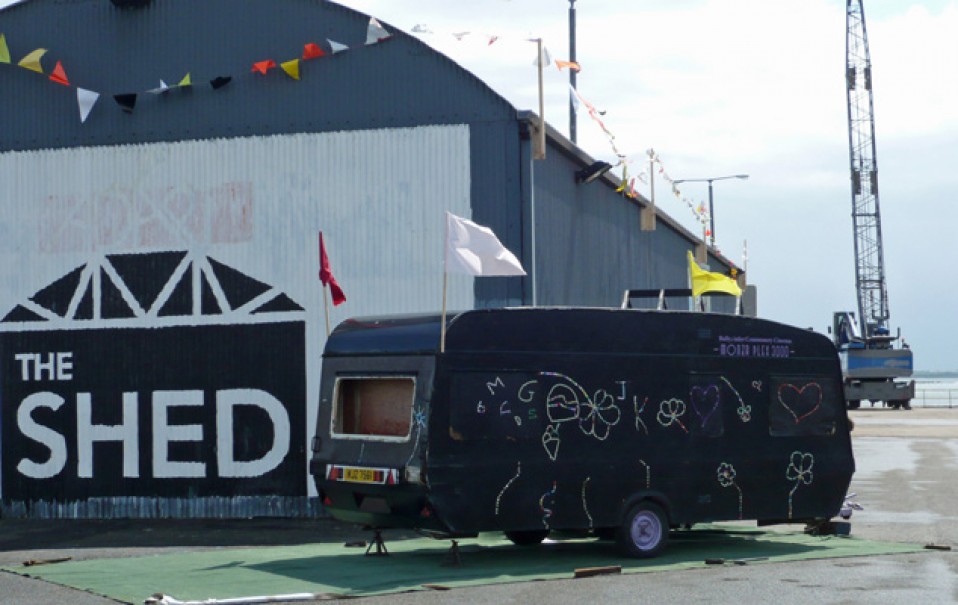
Opening hours
Wed- Fri 12-6pm, Sat-Sun 11-6pm
PS² in Galway
'5 ways to say your prayers'. Part of 'Too many dinner parties'
Anne-Marie Dillon, Julie Miller, Vicky Smith, Joan Sugrue, Phil Hession, Austin Ivers, Carol Anne Connolly, Catherine McGrath, Ruby Wallis, Emma O’Sullivan; Ruth Morrow, curatorial assistant
Ends 21 July 2013
PS² never did a project beyond a 20 miles radius from its project space. But following an invitation by Engage Studios and its artist/ curators Vicky Smith, Carol Anne Connolly and Grace Mitchell, it scaled up ten fold and moved to Galway, for one month to set up an outpost.
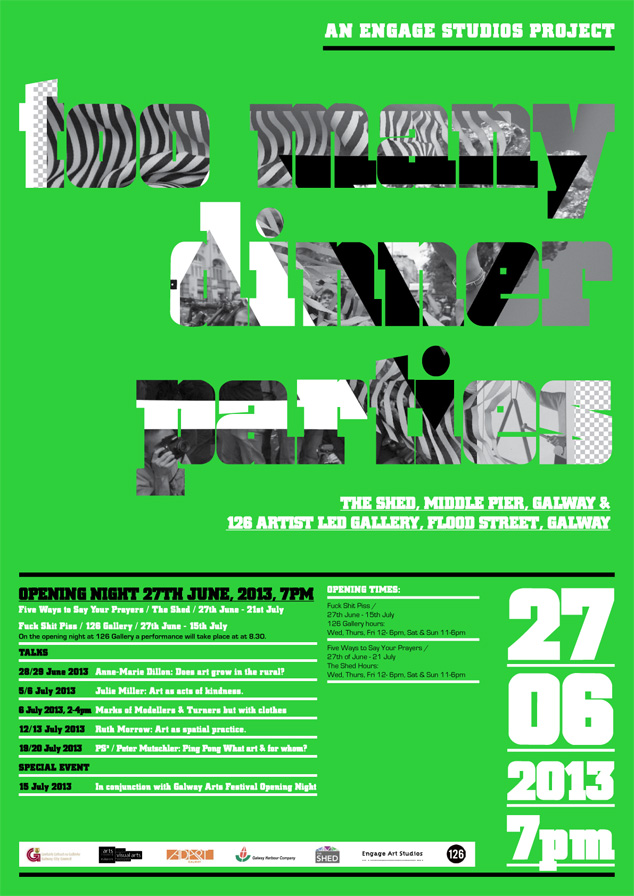
Poster
'5 ways to say your prayers' takes place at The Shed in the centre of the harbor pier and shows work by artists, an academic researcher and PS² which exemplify the work and curatorial programme of the initiative.
‘Five ways to say your prayers’ places objects and situations of recent PS² projects into a new context. Although different in their artistic realization, these five situations have a common concern for social engagement and interaction and represent the curatorial approach of PS².
From a cinema caravan to a ping-pong table and an ironing board, the work can be seen as sculptures and installations and as propositions for local re-activations and new additions. In this way, the mutual social and creative approach is reflected in the curatorial format of an open and on-going project through the involvement of artists, visitors, community groups or ad-hoc initiatives.
‘Five ways to say your prayers’ can be critically measured against terms such as ‘social engagement’, ‘acts of kindness’, ‘mutuality’ or ‘agape’, alluding to religious demands transferred to a secularized art context.
Julie Miller: Come let me lighten your (ironing) load
PS, 2011
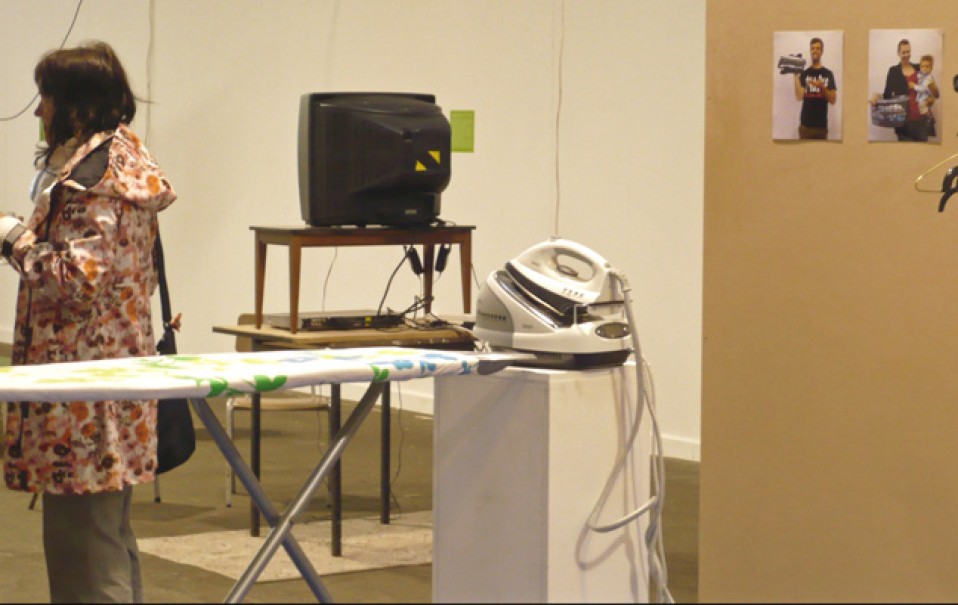
Julie Miller: Come let me lighten your (ironing) load
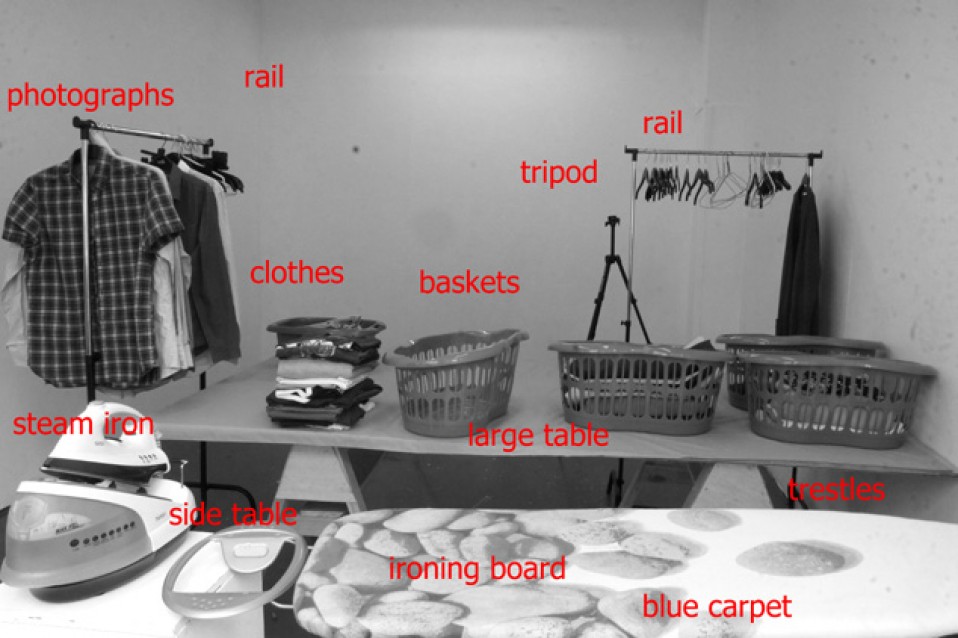
Julie Miller: Come let me lighten your (ironing) load
This project was the second in a series of actions intended to explore the idea of the gift. It investigated the possibility of a temporary free gift through the profane chore of ironing for others without payment. Each participant- or customer- was asked to provide any number of items to be ironed and in a mutual exchange, pose for a photograph giving their name, age and occupation, holding the finished ironing that they brought.
The title directly imitates a Bible quote (Galations 6:9): 'And let us not be weary in well doing: for in due season we shall reap, if we faint not.' It echoes the idea that a gift is not free if it is given in the hope that the giver will benefit. In a text, Julie Miller refers to French sociologist Marcel Mauss, where he describes the giving of free gifts as a falsehood, saying the majority of gifts given are done so in response to gifts given to us or as a way to gain status. ‘What at first seems to be a gift of my time and labour, in producing work for an exhibition may in fact be the participants’ gift to me’.
Ruth Morrow: Departures & Arrivals. Belfast, 2013

Ruth Morrow: Departures & Arrivals
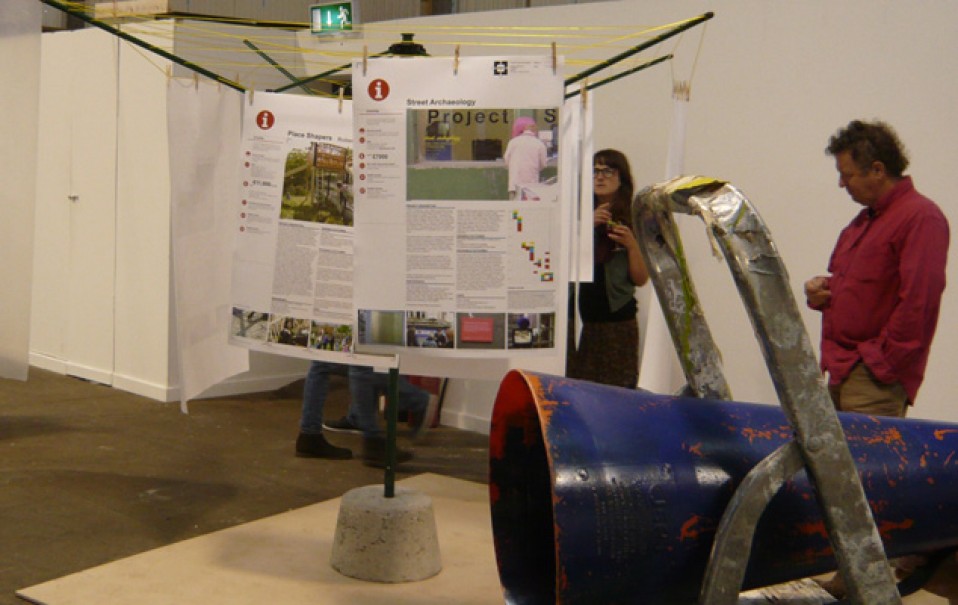
Ruth Morrow: Departures & Arrivals
This work captures and analyses some of PS² ’s projects from the last nine years. Ruth Morrow, an architect and academic, has collaborated with PS2 and its director, Peter Mutschler, since its inception in 2005, acting as curatorial advisor specifically on off-site projects. Many of the longer term and complex projects were and are located beyond PS² ’s city centre location; in peripheral and overlooked communities and in sites typically seen as places of low cultural activity. The projects have a particular focus on active intervention and social interaction between local people, artists, cultural practitioners, architects, multidisciplinary groups and theorists etc in contested sites.
This installation, academic in its research, is displayed in an installation in a mix of classroom/ learning and domestic routine/ washing line.
Ruth Morrow hangs out PS2 ’s (dirty) linen, exposing the stained, creased, patched and in parts well-worn strategies it undertakes in an attempt, to build not only space for community, but also community creativity.
Within the curatorial intention of ‘5 ways to say your prayers’ to invite local responses, projects from other practitioners working in similar ways, Blaithin Quinn, Robert Burke and Kate Dowling are also lined up. As the exhibition develops, we invite others for additional material.
Anne-Marie Dillon: Monza Plex 3000
Ballykinlar community cinema, 2010/11
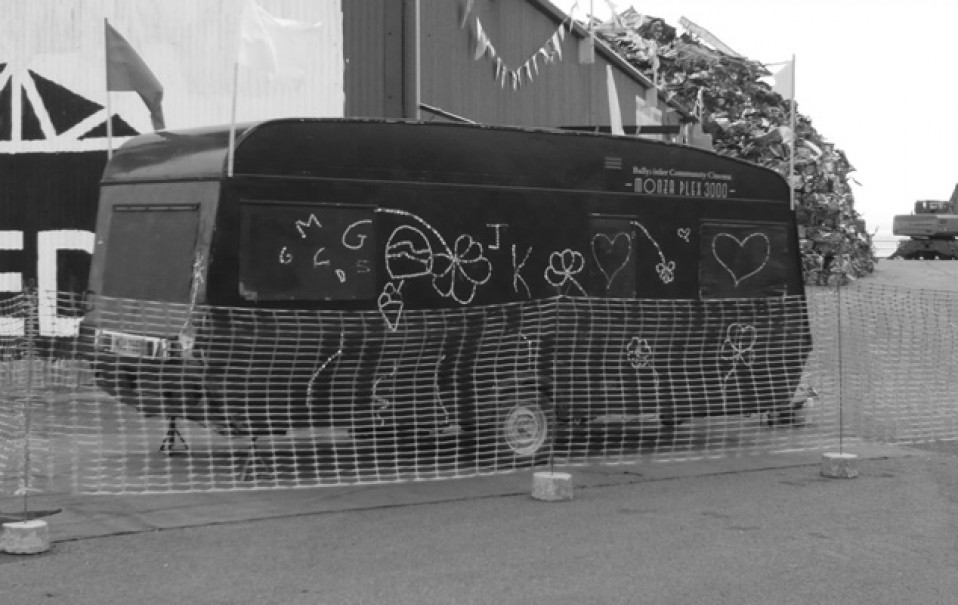
Monza Plex 3000 cinema- Anne-Marie Dillon
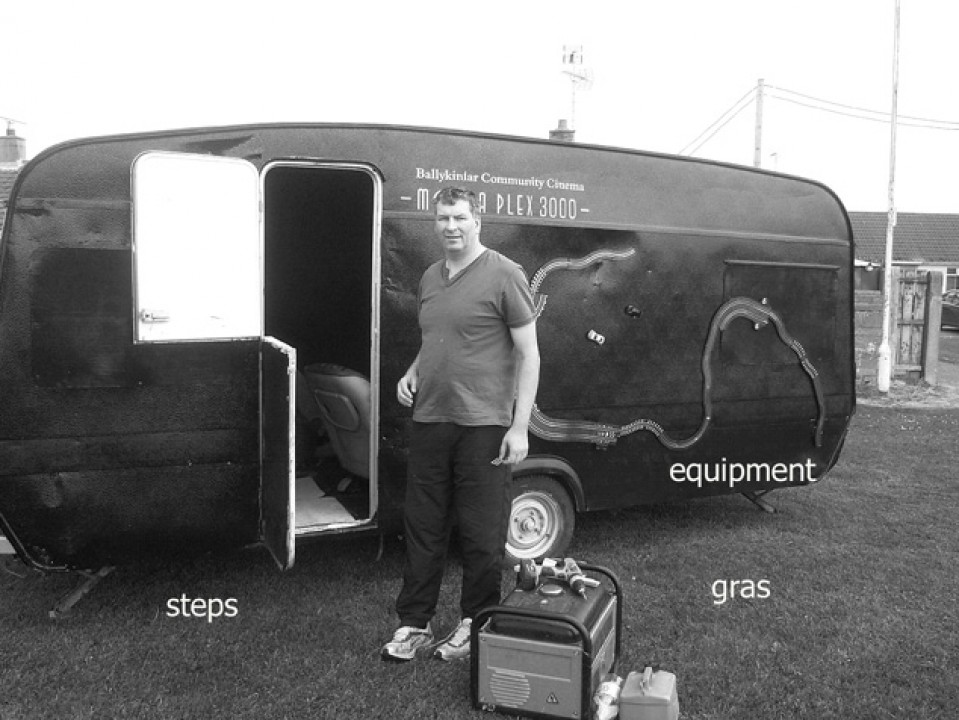
Monza Plex 3000 cinema- Anne-Marie Dillon
Following on from the success of the ‘Ballykinler Mobile Community Centre’ (a converted caravan decorated with roses, kitted out like a living room and mainly used by the ‘Forever Young Pensioners’), the mobile cinema was a community project for and by the young adults in the village. In need of their own space and cultural identity, recycling and conversions were high on the agenda for the teenagers. The process of refurbishment of a donated old caravan took nearly one year, interrupted by set-backs, changing interests and lack of support.
Through the ‘UP-Down’ project by PS² in 2010/11 and a village fair as a final presentation of the outcomes, the cinema caravan got the necessary boost and ambition for a completion. A group of 10 young people worked on the project, collecting old car seats, rewiring the interior, structural repairs and decoration. It was first used at the village fair in 2011 and later for regular screenings of films, videos and the occasional party in the village; small but important events of collectivity and non-profit-making cultural entertainment.
The films and videos which will run during the project are contributions from Austin Ivers, Carol Anne Connolly, Catherine McGrath, Ruby Wallis and Emma O’Sullivan, artists and filmmakers from Galway, responding to an open call.
A documentation by Phil Hession about the making of the caravan by the Ballykinler youths will be screened indoors.
Anne-Marie Dillon: Coffee mornings
May- September 2009, Commons Road, Ballykinler
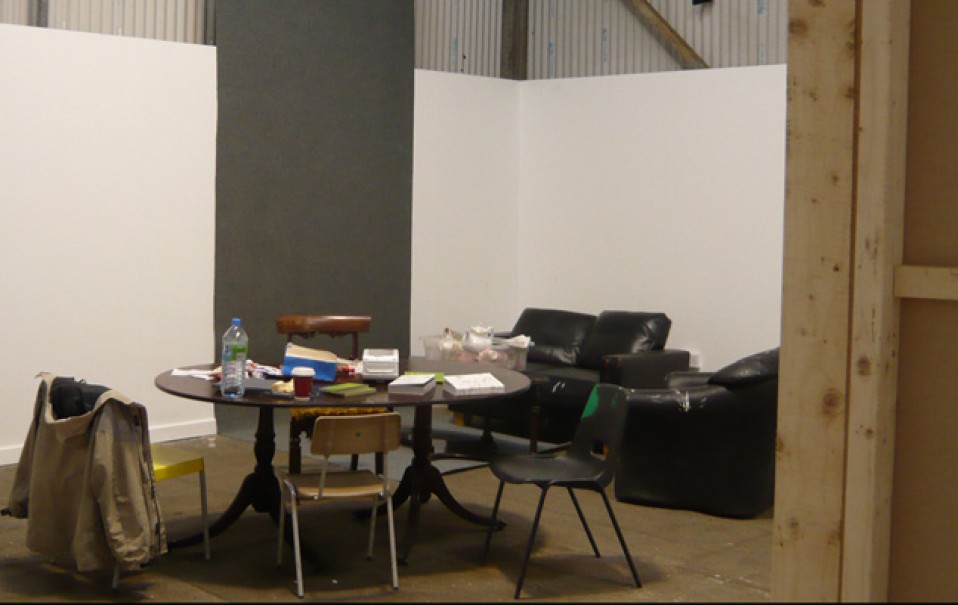
Anne-Marie Dillon- Coffee mornings
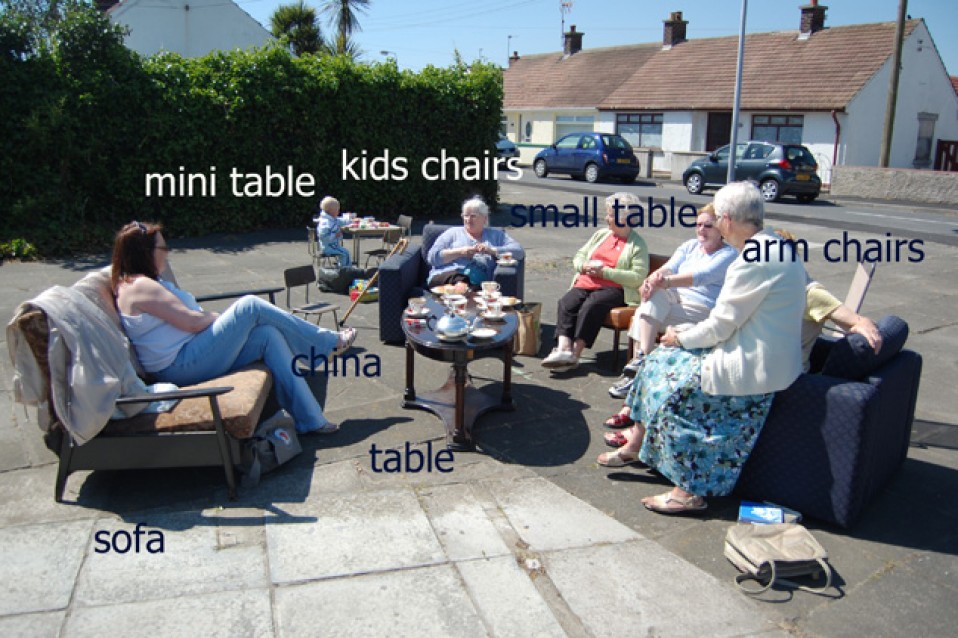
Anne-Marie Dillon- Coffee mornings
Spatial provisions for community- and cultural activities are rare in rural areas. How to create space with and for a community through art and actions is a central theme in Anne-Marie Dillon’s work. As a pragmatic step, she started to place the contents of her living room once a week over several months on the pavement of the appropriately named ‘Commons Road’. With tables, chairs, small seats for the children and a comfortable sofa for the elderly spread out over the pavement, she created a semi-private space in the open. Reclaiming the use of space for the community, her strategy was and is that of an ‘aggressive cosiness’, a near over exaggeration of domestic situations and habits transposed into the public realm. With tea and cake served on china and activities ranging from oral history, music, play and Bingo, these sessions quickly became a welcome routine in the village life, mainly for pensioners and mothers with young children. As a provocation for some, an artistic happening for others and glorious hours together for the participants, these ‘sit-ins’ stopped in autumn 2009 and were continued in the ‘Ballykinler Mobile Community Centre’, a highly decorative, refurbished caravan, small but rainproof.
PS²: Urban sports, play for free
Public squares in Belfast, 2012/13
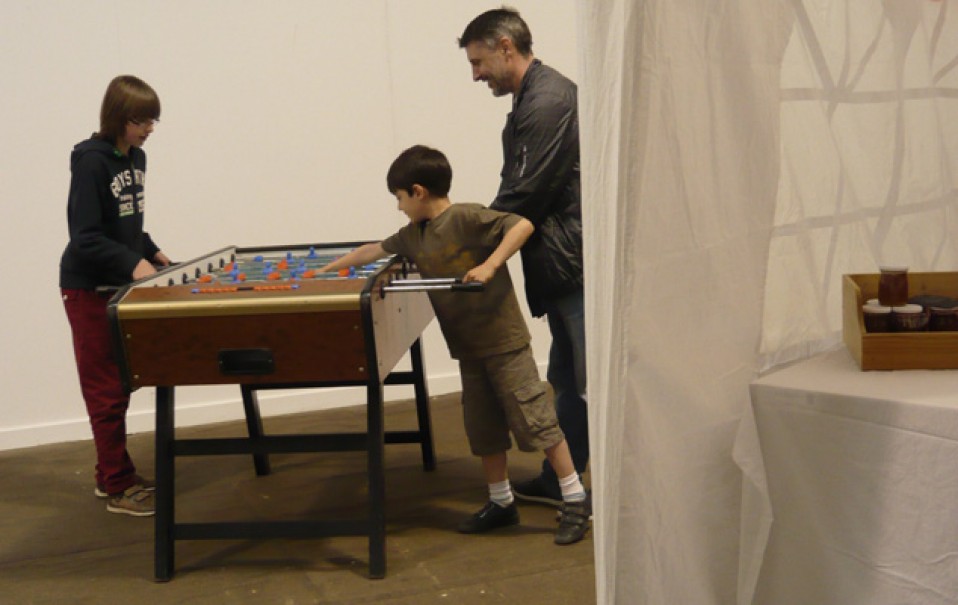
PS²: Urban sports, play for free
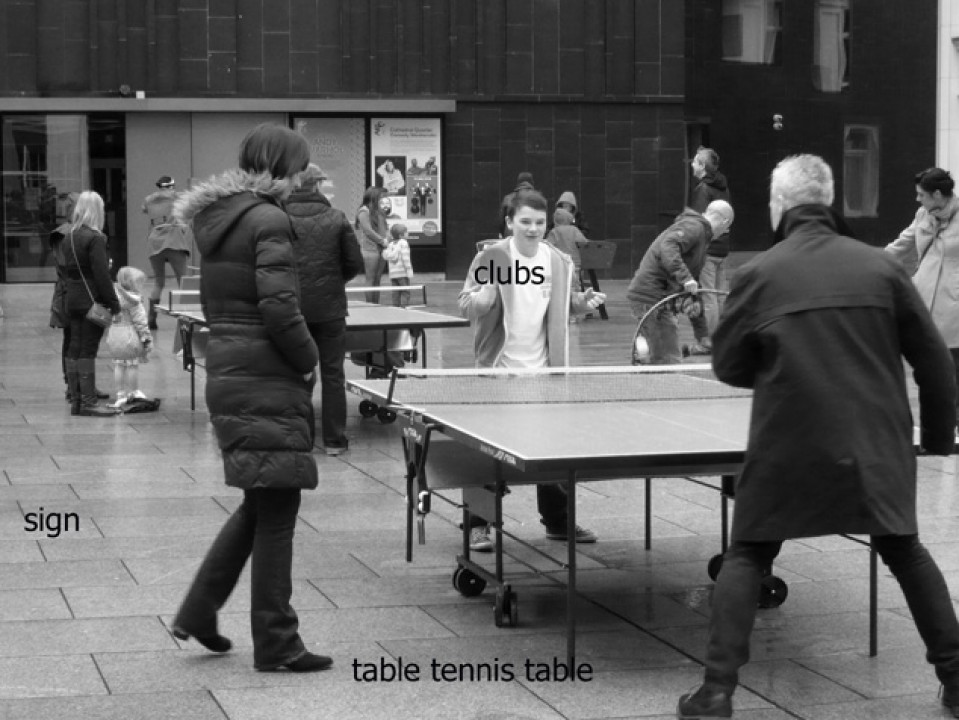
PS²: Urban sports, play for free
This set up with ping-pong table and table football is a reduced version of recent projects by PS² in the public realm, using games and sport as means to activate underused public space. By offering free provisions for play, from ping pong to hula-hoop or skipping ropes, passers-by are invited to join in, interrupt their shopping or usual habits, and show their sporty side.
It was and is a very popular set-up which passers-by quickly used in full, be it as players or observers. Besides the fun and physical exercise, urban sports is seen by PS² as a spatial installation, open for interaction. With all its diverse micro-movements, it provides a stage set for a choreography of city users and an instrument of measuring and experiencing space through play.
As PS² is not a sports club, we were keen to work with artists, asking them to interact with people, activate the situation. Standing on a ladder and acting as partial referee, shouting slogans, commands or prayers were some of the methods used to creatively disturb the pure sporty side, turning the interaction into absurd happenings. Do give it a go.
Joan Sugrue: Stories for Jam
Galway, 2013
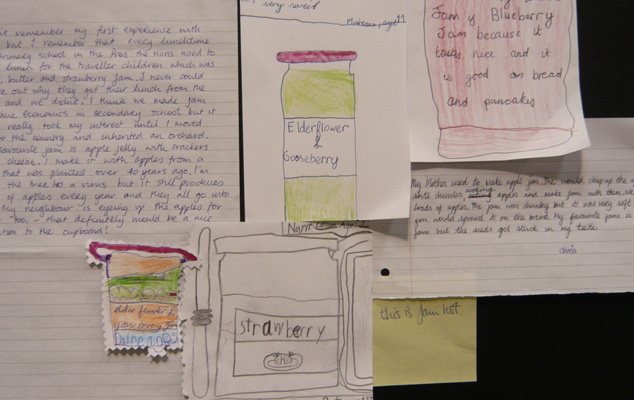
Joan Sugrue: Stories for Jam
Together with Vick Smith, this project was selected from an open call for cultural practitioners in Galway, to respond to the situations and actions of the artists and/ or the curatorial outline of PS².
Jam-making has long been an activity valued in the home. At one time it was a necessary part of the work carried out by women, who used gluts of fruit to make jams and jellies not only to make the fruit last but to provide much needed vitamin C over the winter months. In ‘The second Sex’, the French philosopher and feminist Simone de Beauvoir compared jam-making to the capturing of time:
‘There is enchantment in these alchemies, there is poetry in making preserves, the housewife has caught duration in the snare of sugar, she has enclosed life in jars.’
The public is invited to engage with the artist by offering their own stories, anecdotes or recipes in exchange for a jar of preserves. The stories may be offered in written form or told to the artist and are posted together with the recipes on the blackboard. The jams are made on site with locally sourced fruit and flowers such as blackcurrant, gooseberry, elderflower and lavender.
Vicky Smith: Marks of Modellers and Turners but with clothes
Galway, 2013
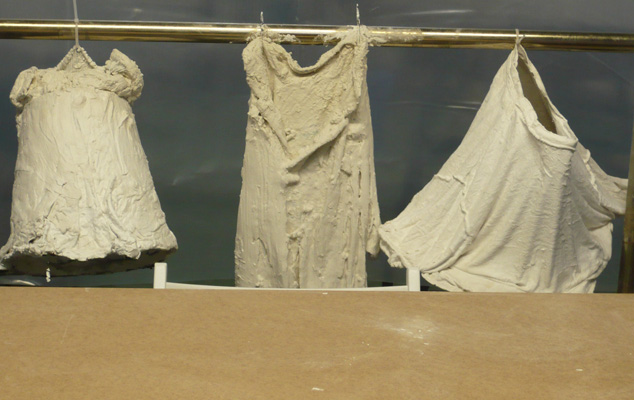
Vicky Smith: Marks of Modellers and Turners but with clothes
Together with Joan Sugrue, this project was selected from an open call for cultural practitioners in Galway, to respond to the situations and actions of the artists and curatorial outline of PS². As an equal addition to the ‘5 ways to say your prayers’, Vicky Smith takes Julie Miller’s work as the trigger for her contribution.
For her workshop set-up, she invites contributors through adverts and open calls to donate old clothing. In different sessions during the course of the project, these clothes are then washed with plaster, dried and returned to the owner as a gift and Fine Art sculpture.
The given clothes, charged with personal history, turn into a white sculptural piece with new functionality as they change into an aesthetic /or non-aesthetic art objects similar to Marcel Duchamp’s infamous defunct Fountain from 1917.
By including the active element of an interaction and exchange between a willing participant- donor, and the open process of casting, Vicky Smith creates an installation of these mutual exchanges between producer, participants, personal objects and materials. This process is visible in the traces of work, as cast objects and later in photographs of these objects repositioned in the owner’s home.
5 ways to say your prayers- talks
Every Saturday @ 2pm in The Shed
29 June 2013: Anne-Marie Dillon: Does art grow in the rural?
Anne-Marie Dillon, artist and activist, lives and works in a small coastal village in Co Down, Northern Ireland, surrounded by sea, fields and a large British Army camp.
The cinema caravan, a project together with young people and her open community centre with seating in the public, put together once a week with pensioners, are examples of provocative and relevant art in the (rural) public. Her talk will focus on her socially engaged art practice and experience of working with a diverse community in a village context.
6 July 2013: Julie Miller: Art as acts of kindness.
Performances and gestures as gifts and acts of kindness are a central theme in Julie Miller’s work. Adopting formats and rituals from religion, she often applies inherent social demands in her activities which mostly happen in the public and beyond a gallery context.
Julie Miller tests the role of the artist in society and the mutual relationship between the producer and receiver, proposing a new economy, both in art and in real life.
13 July 2013: Ruth Morrow: Art as spatial practice.
As architect, academic and curatorial adviser, Ruth Morrow shows research into various off-site projects of PS², underlining the importance of multidisciplinary approaches. Can the ‘situations’ installed in this exhibition be seen as spatial practice, as architecture without the building? And what is built instead?
20 July 2013: PS² - Peter Mutschler: Ping// Pong
What art and for whom? Peter Mutschler, artist and reluctant curator of PS² is interested in art and cultural practices which can play a role in our society and provoke critical debate.
Within the constant struggle between autonomy and social obligation of contemporary art, he thinks in terms of a complete transfusion of art and life. Does art need a pedestal and its own space or can it happen everywhere?
For more information about Engage Studios, Galway see here.
Artist links:
Vicky Smith: www.vickysmith.ie/
Julie Miller: http://makingsomethingsmallhappen.wordpress.com/
Ruth Morrow: http://driftingwalls.blogspot.co.uk
Joan Sugrue: http://www.joansugrue.com/
Carol Anne Connolly: www.carolanneconnolly.com/
Anne-Marie Dillon: http://villageworks.org.uk/wp/artists/
Phil Hession:http://goldenthreadgallery.co.uk/artist/phil-hession/
Austin Ivers: http://vimeo.com/user8302547
Ruby Wallis: www.rubywallis.com/

